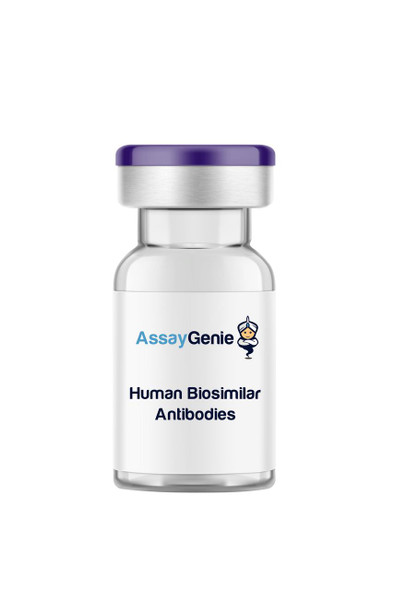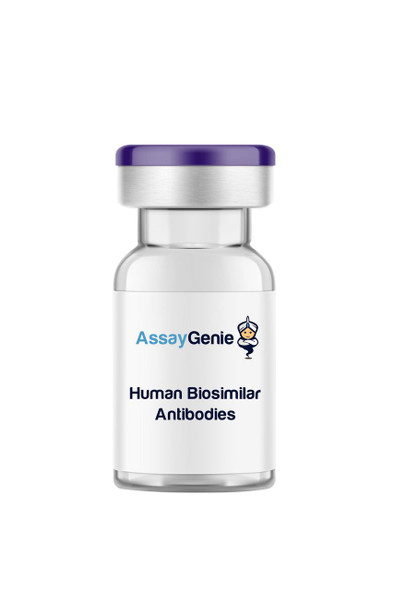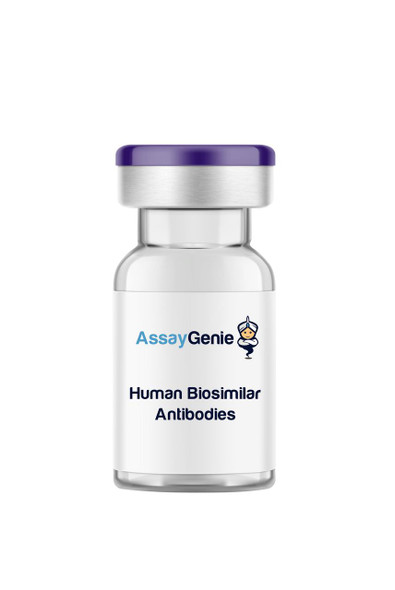Tabalumab (Anti-CD257 / BAFF) Biosimilar In Vivo Antibody
- SKU:
- IVMB0213
- Product Type:
- Biosimilar In Vivo Antibody
- Antibody Type:
- Monoclonal Antibody
- Protein:
- BAFF
- Clone:
- Tabalumab
- Isotype:
- IgG1 kappa
- Reactivity:
- Human
- NHP - Cynomolgus Monkey
- Rabbit
- Synonyms:
- DTL, BLYS, TALL1, THANK, ZTNF4, TALL-1, TNLG7A, TNFSF20, TNFSF13B
Frequently bought together:
Description
system_update_altDatasheet
| Product Name: | Tabalumab (Anti-CD257 / BAFF) Biosimilar In Vivo Antibody |
| Product Code: | IVMB0213 |
| Clone: | Tabalumab |
| Protein: | BAFF |
| Product Type: | Biosimilar Recombinant Human Monoclonal Antibody |
| Synonyms: | DTL, BLYS, TALL1, THANK, ZTNF4, TALL-1, TNLG7A, TNFSF20, TNFSF13B |
| Isotype: | Human IgG1κ |
| Reactivity: | Human/Cynomolgus Monkey/Rabbit |
| Immunogen: | Original antibody was raised against soluble human BAFF. |
| Applications: | ELISA, FA, FC, IF, IP, N, WB |
| Formulation: | This biosimilar antibody is aseptically packaged and formulated in 0.01 M phosphate buffered saline (150 mM NaCl) PBS pH 7.2 - 7.4 with no carrier protein, potassium, calcium or preservatives added. Due to inherent biochemical properties of antibodies, certain products may be prone to precipitation over time. Precipitation may be removed by aseptic centrifugation and/or filtration. |
| Endotoxin Level: | < 1.0 EU/mg as determined by the LAL method |
| Purity: | ≥95% monomer by analytical SEC |
| Preparation: | Functional grade preclinical antibodies are manufactured in an animal free facility using only In vitro protein free cell culture techniques and are purified by a multi-step process including the use of protein A or G to assure extremely low levels of endotoxins, leachable protein A or aggregates. |
| Storage and Handling: | Functional grade biosimilar antibodies may be stored sterile as received at 2-8°C for up to one month. For longer term storage, aseptically aliquot in working volumes without diluting and store at -80°C. Avoid Repeated Freeze Thaw Cycles. |
| Applications: | ELISA, FA, FC, IF, IP, N, WB |
| Recommended Usage: | FC The suggested concentration for Tabalumab biosimilar antibody for staining cells in flow cytometry is ≤ 0.25 µg per 106 in a volume of 100 µl. Titration of the reagent is recommended for optimal performance for each application. |
| Reactivity: | Human/Cynomolgus Monkey/Rabbit |
| Specificity: | This non-therapeutic biosimilar antibody uses the same variable region sequence as the therapeutic antibody Tabalumab. Tabalumab neutralizes soluble human, cynomolgus monkey, and rabbit BAFF. Additionally, Tabalumab neutralizes membrane-bound BAFF. This product is for research use only. |
| Antigen Distribution: | BAFF is expressed on various cell types including monocytes, dendritic cells and bone marrow stromal cells. |
| Immunogen: | Original antibody was raised against soluble human BAFF. |
| Concentration: | ≥ 5.0 mg/ml |
| Endotoxin Level: | < 1.0 EU/mg as determined by the LAL method |
| Purity: | ≥95% monomer by analytical SEC |
| Formulation: | This biosimilar antibody is aseptically packaged and formulated in 0.01 M phosphate buffered saline (150 mM NaCl) PBS pH 7.2 - 7.4 with no carrier protein, potassium, calcium or preservatives added. Due to inherent biochemical properties of antibodies, certain products may be prone to precipitation over time. Precipitation may be removed by aseptic centrifugation and/or filtration. |
| Preparation: | Functional grade preclinical antibodies are manufactured in an animal free facility using only In vitro protein free cell culture techniques and are purified by a multi-step process including the use of protein A or G to assure extremely low levels of endotoxins, leachable protein A or aggregates. |
| Storage and Handling: | Functional grade biosimilar antibodies may be stored sterile as received at 2-8°C for up to one month. For longer term storage, aseptically aliquot in working volumes without diluting and store at -80°C. Avoid Repeated Freeze Thaw Cycles. |
| Protein: | BAFF |
| Ligand/Receptor: | BR3, TACI, BCMA |
| Research Area: | Cell Biology, Costimulatory Molecules, Immunology, Signal Transduction, Stem Cell |










